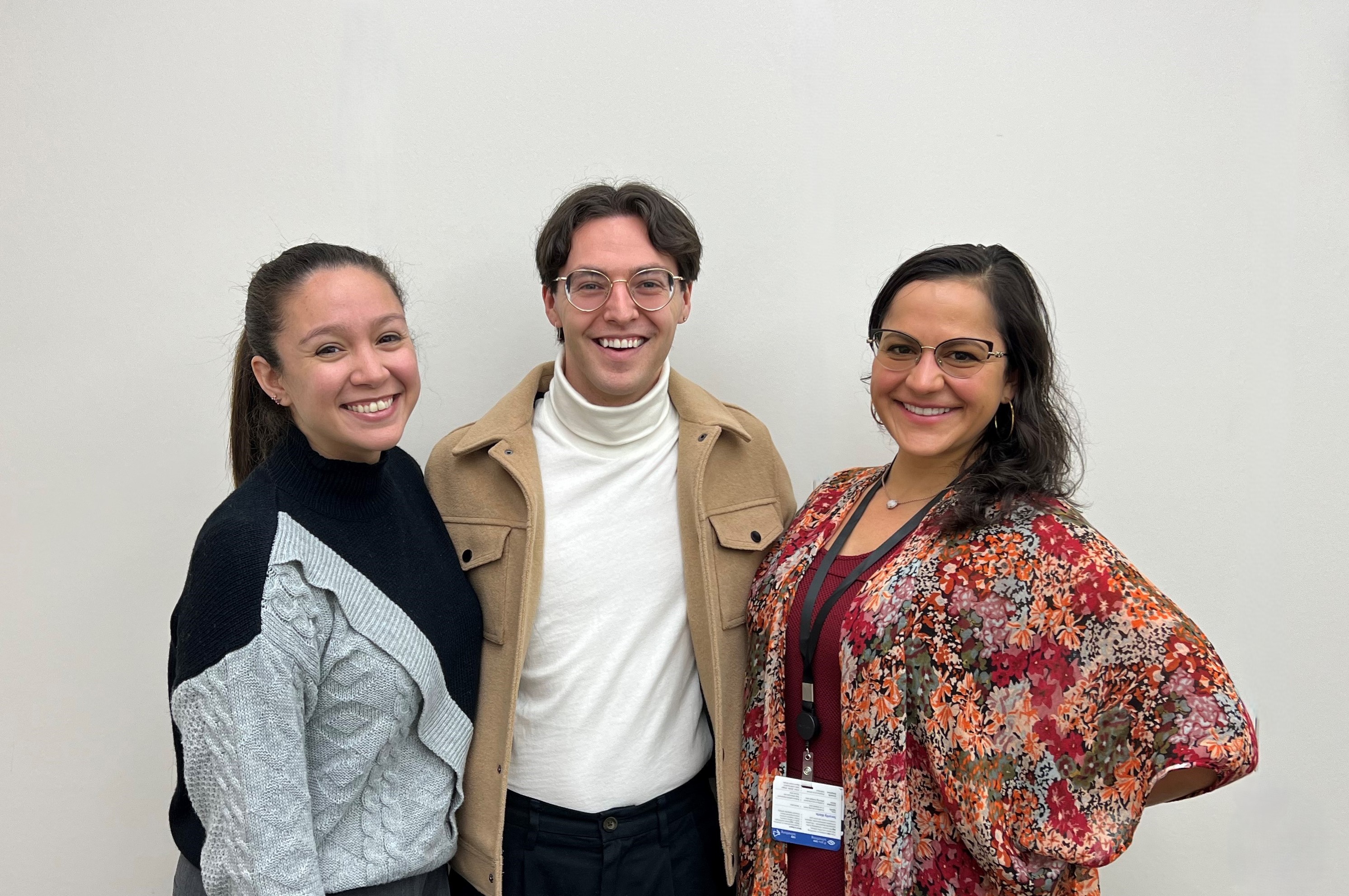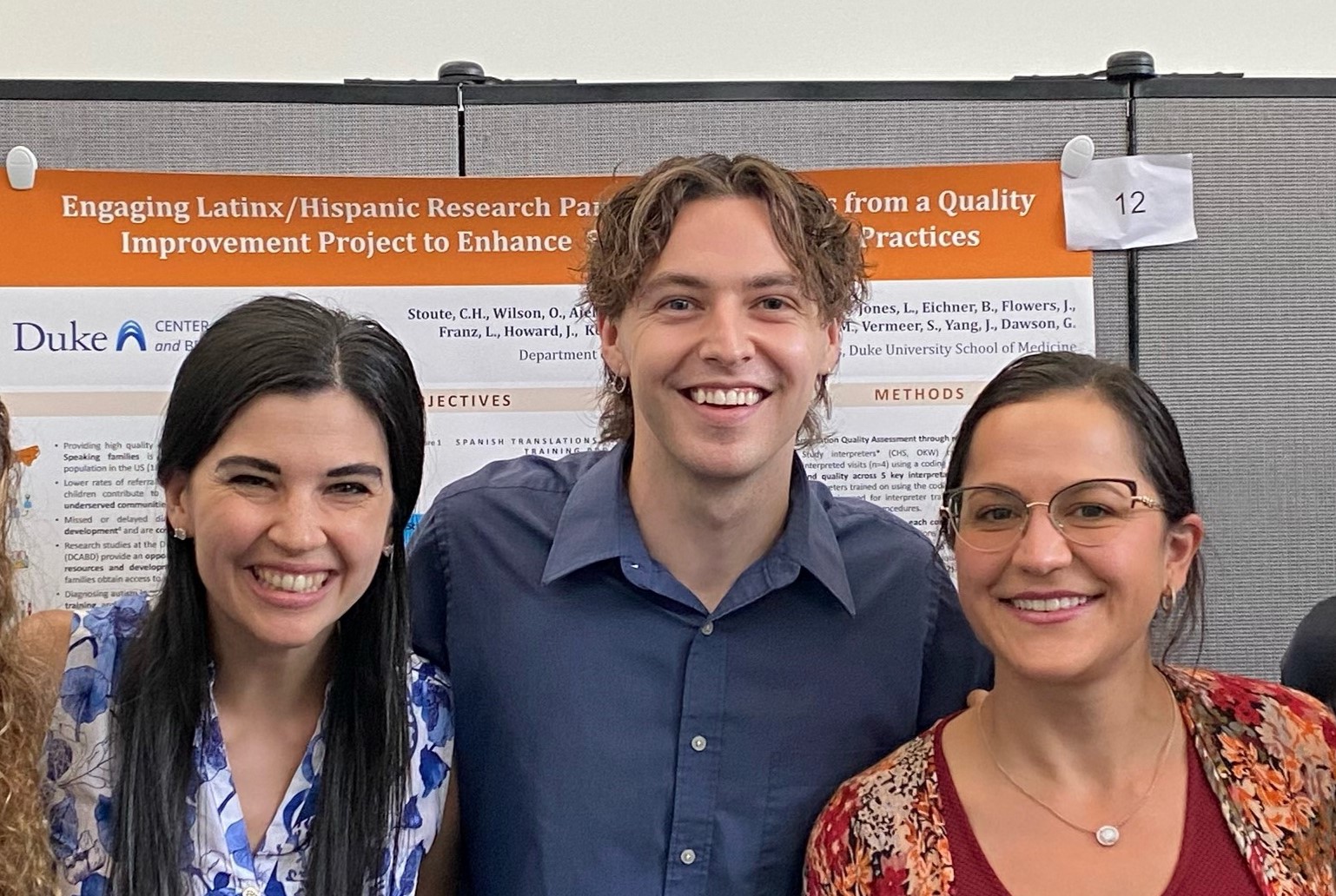
Spanish is the second most common language in the United States and Durham, North Carolina, with about 13 percent of the Durham community primarily speaking Spanish at home. By law, clinics with patient services must make their services accessible when a language is strongly represented in the community. However, scientific research is not always accessible to Spanish-speaking families.
At the Duke Center for Autism and Brain Development, researchers are working to ensure that research outcomes are broadly applicable. The research team conducting one of the NIH Autism Center of Excellence projects focused on improving early autism screening has developed strategies to include children and families who represent the diversity of the whole population.
“We strive for our results to reflect the community, and by the end, to have a product that works for everyone.”
- Charlotte Stoute, CCRP, regulatory coordinator at the Duke Center for Autism and Brain Development.
The product in development is a mobile app for autism screening that can be administered by a clinician during a visit or by a caregiver at home.
Care in Translation
The research team, which includes Spanish-speaking staff, partners with interpretation services to bring Spanish-speaking families into the study. Interpretation goes beyond direct translation. All materials presented to families at all stages of the study are not only understandable but culturally appropriate. That includes providing informed consent forms, flyers, brochures, study instructions, the app itself, and the website for the study in Spanish.
Particular attention is given to the recruitment and informed consent wording during the conversations and review of consent forms when a family joins the study. “We emphasize the voluntary aspect of participating,” says Stoute.
Some things don’t translate directly. For example, in the caregiver interview, a general question such “How does your child sleep?” is adapted to a more specific question like, “What is your child’s sleep routine?” Questions about developmental concerns or parenting choices may be seen as offensive or intrusive rather than helpful. These conversations are conducted in a direct, but culturally sensitive way.
“My goal is for English and Spanish speaking parents and children to have the same experience. Every detail from intake to the books we give out as prizes should be equivalent,” says Owen Wilson, a senior clinical research specialist and Spanish language interpreter.
This goal is not always possible, and factors outside of language can lead to differences in Spanish-speaking families’ ability participate. Translation is just one part of preparing the study for Spanish-speaking participants.

Barriers to Research Participation
Other factors have historically limited the medical establishment’s ability to connect with Spanish-speaking communities. The team strives to build trust and show that they understand the family’s needs and values before they enroll.
Some Spanish-speaking families in Durham are less likely to have access to the resources that would allow them to participate as readily as English speakers. This can include transportation, time, childcare, and where they might see information about the study in the first place.
The perception of early developmental milestones and behaviors associated with autism may also differ in Hispanic communities. Cultural norms around language development, eye contact, and personal space are understood differently in Latin America, and a child’s behaviors may not necessarily be a sign of concern to caregivers. Traditional autism screening questions often miss children of color and non-English-speaking children because the questions do not align with how caregivers perceive and communicate about their child’s behavior.

Cultural Ambassadors
The research team’s interpreters serve as cultural ambassadors between the families and the clinicians who will be conducting the child’s diagnostic evaluation. “There is an extraordinary amount of diversity [among Spanish speakers] from country of origin, heritage, community, family, down to individual differences,” says Stoute.
“There is an extraordinary amount of diversity [among Spanish speakers] from country of origin, heritage, community, family, down to individual differences.”
- Charlotte Stoute, CCRP
Without trying to influence a diagnosis or decision, the interpreter can explain behaviors within cultural contexts. Interpreters may have to get creative with language. If a TV show or song is used as an example by the clinician, the interpreter might change it to something common and more relevant to the child’s cultural context that the family would be familiar with.
“We’re here to provide accurate interpretation, to make sure that everything that is said by the clinician or the family in a study visit is fully communicated and understood.”
- Owen Wilson
Led by Geraldine Dawson, PhD, and Guillermo Sapiro, PhD, the research study is validating whether an autism screening app, currently in development, can be administered by caregivers at home. The brief video clips shown as part of the app are available in English and Spanish, and the actors in the movies are ethnically and racially diverse. The interpreters on the research team are working to ensure that caregivers who speak Spanish at home can use the app with their children with equally reliable results. They hope to break through cultural barriers that have historically excluded Spanish speakers from medical and developmental research to build a tool that will increase the accuracy of autism screening and reduce the disparities in access to early therapy and supports for all children who need them.
Los servicios de interpretación hacen que la investigación de Duke sea accesible para los hispanohablantes
Este artículo ha sido traducido por los intérpretes de SenseToKnow.
El español es el segundo idioma más común en los Estados Unidos y Durham, Carolina del Norte, con alrededor del 13% de la comunidad extendida de Durham que habla principalmente español en casa. Según la ley, las clínicas con servicios para pacientes deben hacer accesibles sus servicios cuando un idioma está fuertemente representado en la comunidad. Sin embargo, la investigación científica no siempre es accesible para las familias hispanohablantes. En el Centro Duke para el Autismo y el Desarrollo Cerebral, los investigadores están trabajando para garantizar que los resultados de la investigación sean ampliamente aplicables. El equipo de investigación que lleva a cabo uno de los proyectos del Centro de Excelencia para el Autismo de los Institutos Nacionales de la Salud (NIH, por sus siglas en inglés) en mejorar la detección temprana del autismo ha desarrollado estrategias para incluir a los niños/as y las familias que representan la diversidad de toda la población.
Nos esforzamos para que nuestros resultados reflejen a la comunidad y, al final, para tener un producto que funcione para todos, dice Charlotte Stoute, CCRP, coordinadora regulatoria del Centro Duke para el Autismo y el Desarrollo Cerebral.
El producto en desarrollo es una aplicación móvil para la detección del autismo que puede ser administrada por un proveedor de salud durante una cita o por un cuidador en casa.
Cuidado en la traducción
El equipo de investigación, que incluye personal hispanohablante, se esmera en los servicios de interpretación para poder incluir a las familias hispanohablantes en el estudio. La interpretación va más allá de la traducción directa. Todos los materiales presentados a las familias en cada paso del estudio no solo son comprensibles, sino también culturalmente apropiados. Esto incluye proporcionar formularios de consentimiento, folletos, panfletos, instrucciones para el estudio, la aplicación y el sitio web para el estudio en español.
Se presta especial atención al proceso de reclutamiento y al consentimiento informado durante las conversaciones y la revisión de los formularios de consentimiento cuando una familia se une al estudio. Enfatizamos al aspecto voluntario de participar, dice Stoute.
Algunas cosas no se traducen directamente. En la entrevista del cuidador, preguntas como “¿cómo duerme su hijo/a?” se adaptan a preguntas más específicas como “¿Cuál es la rutina de sueño de su hijo/a?”, por ejemplo. Las preguntas sobre las preocupaciones acerca el desarrollo o las opciones de crianza pueden considerarse ofensivas o intrusivas en lugar de útiles. Estas conversaciones se llevan a cabo de una manera directa, pero culturalmente sensible.
Un objetivo mío es que los padres e hijo/a que hablan inglés y español tengan la misma experiencia. Todos los detalles, desde la admisión hasta los libros que entregamos como premios, debe ser equivalente, dice Owen Wilson, especialista senior en investigación clínica e intérprete de español.
Este objetivo no siempre es posible, y factores fuera del idioma pueden llevar a diferencias en la capacidad de participación de las familias hispanohablantes. La traducción es solo una parte de la preparación del estudio para los participantes hispanohablantes.
Barreras a la participación en la investigación
Otros factores han limitado históricamente la capacidad del establecimiento médico para conectarse con las comunidades hispanohablantes. El equipo se esfuerza por generar la confianza y demostrar que entienden las necesidades y valores de la familia antes de inscribirse.
Algunas familias hispanohablantes en Durham tienen menos probabilidades de tener acceso a los recursos que les permitirían participar tan fácilmente como los que hablan inglés. Esto puede incluir el transporte, el tiempo, el cuidado de los niños/as y dónde podrían ver información sobre el estudio en primer lugar.
La percepción de los hitos temprano del desarrollo y los comportamientos asociados con el autismo también pueden diferir en las comunidades hispanas. Las normas culturales con respecto al desarrollo del lenguaje, el contacto visual y el espacio personal se entienden de manera diferente en América Latina, y los comportamientos de un niño/a pueden no ser necesariamente un signo de preocupación para los cuidadores. Los cuestionarios tradicionales de detección de autismo a menudo pasan por alto a los niños/as de color y a los niños/as que no hablan inglés porque las preguntas no se alinean con la forma en que los cuidadores perciben y se comunican sobre el comportamiento de su hijo/a.
Embajadores culturales
Los intérpretes del equipo de investigación sirven como embajadores culturales entre las familias y los médicos que llevarán a cabo la evaluación diagnóstica del niño/a.
Existe una extraordinaria diversidad [entre las personas hispanohablantes] desde del país de origen, el patrimonio, la comunidad, la familia hasta las diferencias individuales, dice Stoute.
Sin tratar de influir en un diagnóstico o decisión, el intérprete puede explicar comportamientos dentro de contextos culturales. Es posible que los intérpretes tengan que ser creativos con el lenguaje. Si el médico utiliza un programa de televisión o canción como ejemplo, el intérprete podría cambiarlo por algo común y más relevante para el contexto cultural del niño/a con el que la familia estaría familiarizada.
Estamos aquí para proporcionar una interpretación precisa, para asegurarnos de que todo lo que dice el médico o la familia en una visita de estudio se comunique y entienda completamente, dice Wilson.
El estudio de investigación, que está dirigido por Geraldine Dawson, PhD, y Guillermo Sapiro, PhD, está validando una aplicación de detección de autismo que se está construyendo para que los cuidadores la administren en casa. Los videoclips que se muestran como parte de la aplicación están disponibles en inglés y español, y los actores de las películas son diversos étnicamente y racialmente. Los intérpretes del equipo de investigación están trabajando para asegurar que los cuidadores que hablan español en casa puedan usar la aplicación con sus hijos/as con resultados igualmente confiables. Esperan deshacer las barreras culturales que históricamente han excluido a las personas hispanohablantes de la investigación médica y del desarrollo para construir una herramienta que aumente la precisión de las pruebas de detección del autismo y reduzca las disparidades en el acceso a la terapia temprana y los apoyos para todos los niños/as que los necesitan.
Perochon, S., Di Martino, J. M., Carpenter, K. L. H., Compton, S., Davis, N., Eichner, B., Espinosa, S., Franz, L., Krishnappa Babu, P. R., Sapiro, G., and Dawson, G. (2023). Early detection of autism using digital behavioral phenotyping. Nature Medicine. 2023 Oct;29(10):2489-2497. PMID: 37783967.
Krishnappa Babu, P.R., Di Martino, J.M. Aiello, R., Eichner, B., Espinosa, S., Green, J., Howard, J., Perochon, S., Spanos, M., Vermeer, S., Dawson, G., and Sapiro, G. (2024). Validation of a mobile app for remote autism screening in toddlers. New England Journal of Medicine – AI. Published online September 26, 2024.